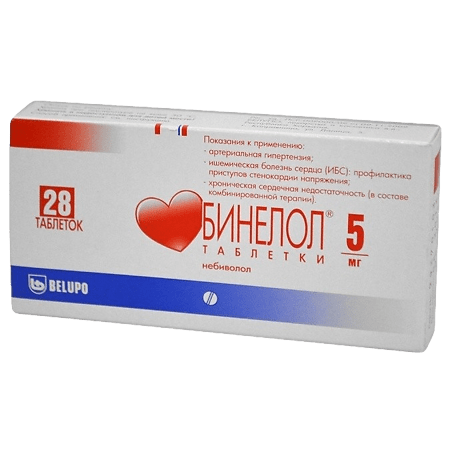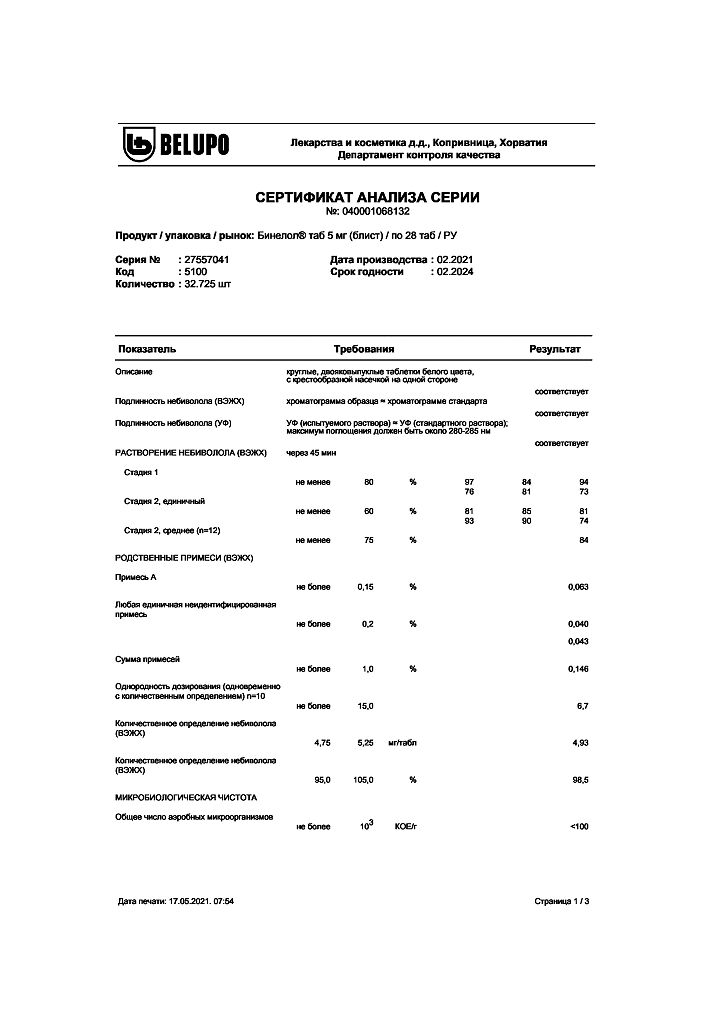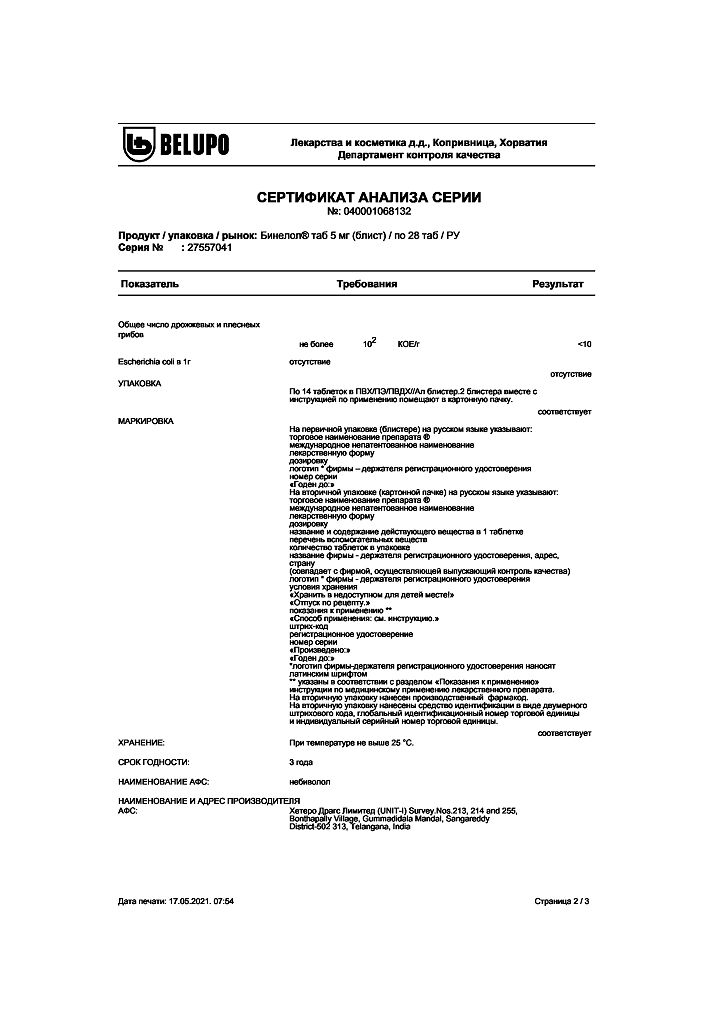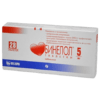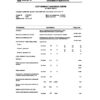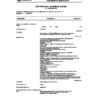No products in the cart.
Binelol, tablets 5 mg 28 pcs.
€23.75 €20.59
Description
Binelolol has antiarrhythmic, hypotensive, antianginal action.
Pharmacodynamics
Nebivololol is a lipophilic, cardioselective β1-adrenoblocker of the third generation with vasodilatory properties. It has hypotensive, antianginal and antiarrhythmic effects. It reduces elevated BP at rest, under physical stress and stress. Competitively and selectively blocks synaptic and postsynaptic β1-adrenoreceptors, making them unavailable for catecholamines, modulates the release of endothelial vasodilatory factor – nitric oxide (NO).
Nebivololol is a racemate consisting of two enantiomers: SRRR-nebivolol (D-nebivolol) and RSSS-nebivolol (L-nebivolol) combining two pharmacological actions:
– D-nebivololol is a competitive and highly selective blocker of β1-adrenoreceptors (affinity for β1-adrenoreceptors is 293 times higher than for β2-adrenoreceptors);
– L-nebivololol has a mild vasodilator effect by modulating the release of relaxing factor (NO) from the vascular endothelium.
Hypotensive effect develops on the 2nd-5th day of treatment, a stable effect is noted after 1 month. Antihypertensive effect is maintained with long-term treatment.
The hypotensive effect is also due to a decrease in the activity of the renin-angiotensin system (does not directly correlate with changes in plasma renin activity).
The use of nebivololol improves indices of systemic and intracardiac hemodynamics. Nebivolol reduces HR and BP at rest and at exercise, decreases left ventricular end-diastolic pressure, decreases PEEP, improves diastolic heart function (decreases filling pressure), and increases ejection fraction.
Limiting myocardial oxygen demand (reduced HR, reduced preload and postload), reduces the number and severity of angina attacks and increases exercise tolerance.
The antiarrhythmic action is due to the suppression of pathological automatism of the heart (including in the pathological focus) and the slowing of AV conduction.
Pharmacokinetics
Intake. After oral administration, nebivolol is rapidly absorbed from the gastrointestinal tract. Food intake does not affect absorption, so nebivololol can be taken regardless of meals. Bioavailability is on average 12% in patients with fast metabolism and is almost complete in patients with slow metabolism. The efficacy of nebivolol does not depend on the metabolic rate.
Distribution. Plasma clearance in most patients (with fast metabolism) is reached within 24 h, and for hydroxymetabolites – after several days. Plasma concentrations (1-30 µg/L) are proportional to the dose.
The binding to plasma proteins (predominantly to albumin) for D-nebivololol is 98.1% and for L-nebivolol is 97.9%.
Metabolism. Nebivolol is actively metabolized, partially with the formation of active hydroxymetabolites. The rate of metabolism of nebivolol by aromatic hydroxylation is genetically determined by oxidative polymorphism and depends on the CYP2D6 isoenzyme.
Evacuation. One week after administration, 38% (the amount of unchanged active ingredient is less than 0.5%) of the dose is excreted by the kidneys and 48% through the intestine.
In patients with fast metabolism the T1/2 values of enantiomers of nebivololol from plasma are on average 10 h. In patients with “slow” metabolism these values are 3-5 times higher.
In patients with fast metabolism the T1/2 values of hydroxymetabolites of both enantiomers from plasma averaged 24 hours; in patients with slow metabolism these values are approximately 2-fold increased.
The pharmacokinetics of nebivololol are not affected by the age and sex of patients.
Indications
Indications
arterial hypertension;
coronary heart disease (prevention of angina attacks);
chronic heart failure (as part of combination therapy).
Pharmacological effect
Pharmacological effect
Binelol has antiarrhythmic, hypotensive, antianginal effects.
Pharmacodynamics
Nebivolol is a lipophilic, cardioselective third-generation β1-blocker with vasodilating properties. It has hypotensive, antianginal and antiarrhythmic effects. Reduces high blood pressure at rest, during physical exertion and stress. Competitively and selectively blocks synaptic and postsynaptic β1-adrenergic receptors, making them inaccessible to catecholamines, modulates the release of the endothelial vasodilating factor – nitric oxide (NO).
Nebivolol is a racemate consisting of two enantiomers: SRRR-nebivolol (D-nebivolol) and RSSS-nebivolol (L-nebivolol), combining two pharmacological actions:
– D-nebivolol is a competitive and highly selective blocker of β1-adrenergic receptors (the affinity for β1-adrenergic receptors is 293 times higher than for β2-adrenergic receptors);
– L-nebivolol has a mild vasodilatory effect by modulating the release of relaxing factor (NO) from the vascular endothelium.
The hypotensive effect develops on the 2nd–5th day of treatment, a stable effect is observed after 1 month. The antihypertensive effect persists with long-term treatment.
The hypotensive effect is also due to a decrease in the activity of the renin-angiotensin system (does not directly correlate with changes in renin activity in the blood plasma).
The use of nebivolol improves systemic and intracardiac hemodynamics. Nebivolol reduces heart rate and blood pressure at rest and during physical activity, reduces end-diastolic pressure of the left ventricle, reduces peripheral vascular resistance, improves diastolic heart function (reduces filling pressure), and increases ejection fraction.
By reducing myocardial oxygen demand (reducing heart rate, reducing preload and afterload), it reduces the number and severity of angina attacks and increases exercise tolerance.
The antiarrhythmic effect is due to the suppression of pathological automatism of the heart (including in the pathological focus) and slowdown of AV conduction.
Pharmacokinetics
Suction. After oral administration, nebivolol is rapidly absorbed from the gastrointestinal tract. Eating does not affect absorption, so nebivolol can be taken regardless of meals. Bioavailability averages 12% in patients with rapid metabolism and is almost complete in patients with slow metabolizers. The effectiveness of nebivolol is independent of metabolic rate.
Distribution. Plasma clearance in most patients (with rapid metabolism) is achieved within 24 hours, and for hydroxymetabolites – after several days. Concentration in blood plasma (1–30 μg/l) is proportional to the dose.
The binding to plasma proteins (mainly albumin) for D-nebivolol is 98.1%, and for L-nebivolol – 97.9%.
Metabolism. Nebivolol is actively metabolized, partially with the formation of active hydroxymetabolites. The rate of metabolism of nebivolol by aromatic hydroxylation is genetically determined by oxidative polymorphism and depends on the CYP2D6 isoenzyme.
Excretion. A week after administration, 38% (the amount of unchanged active substance is less than 0.5%) of the dose is excreted by the kidneys and 48% through the intestines.
In patients with rapid metabolism, T1/2 values of nebivolol enantiomers from blood plasma average 10 hours. In patients with “slow” metabolism, these values increase by 3–5 times.
In patients with rapid metabolism, T1/2 values of hydroxymetabolites of both enantiomers from blood plasma average 24 hours; in patients with slow metabolizers, these values increase approximately 2-fold.
The pharmacokinetics of nebivolol are not affected by the age and gender of patients.
Special instructions
Special instructions
The withdrawal of β-blockers should be carried out gradually over 10 days (up to 2 weeks in patients with coronary artery disease).
Monitoring blood pressure and heart rate at the beginning of taking the drug should be daily.
In elderly patients, monitoring of renal function is necessary (once every 4–5 months).
For exertional angina, the dose of the drug should ensure that the heart rate at rest is within the range of 55–60 beats/minute, and during exercise – no more than 110 beats/minute.
β-blockers may cause bradycardia: the dose should be reduced if the heart rate is less than 50–55 beats/minute.
When deciding whether to prescribe Binelol to patients with psoriasis, the expected benefits of using the drug should be carefully weighed against the possible risk of exacerbation of psoriasis.
Patients who use contact lenses should take into account that the use of beta-blockers may reduce the production of tear fluid.
When performing surgical interventions, the anesthesiologist should be warned that the patient is taking β-blockers.
Nebivolol does not affect glucose levels in patients with diabetes. However, caution should be exercised when treating these patients because Binelol may mask certain symptoms of hypoglycemia (eg tachycardia) caused by the use of hypoglycemic agents.
Plasma glucose levels should be monitored once every 4–5 months (in patients with diabetes mellitus).
β-blockers should be used with caution in patients with COPD as bronchospasm may increase.
β-blockers may increase sensitivity to allergens and the severity of anaphylactic reactions.
The effectiveness of β-blockers in smokers is lower than in non-smoking patients.
Impact on the ability to drive a car or perform work that requires increased speed of physical and mental reactions. Research has shown that nebivolol does not affect the speed of psychomotor reactions. For flight crew pilots with mild arterial hypertension admitted to flight work, the drug is prescribed at an initial dose of 2.5 mg. In the future (no earlier than 2 weeks), if treatment is well tolerated and blood pressure is not well controlled, the dose may be increased by 2.5 mg. The recommended dose is 5 mg/day. Some patients may experience side effects, most commonly dizziness, due to low blood pressure. If such effects occur, the patient should not drive vehicles or engage in potentially hazardous activities that require special attention and speed of psychomotor reactions. These effects most often occur immediately after starting treatment or when the dose is increased.
Active ingredient
Active ingredient
Nebivolol
Composition
Composition
1 tablet contains:
active ingredient:
nebivolol (in the form of nebivolol hydrochloride) 5 mg,
excipients:
lactose monohydrate;
crospovidone (type A);
poloxamer 188;
povidone K30;
MCC;
magnesium stearate
Pregnancy
Pregnancy
During pregnancy, the drug Binelol is prescribed only for strict indications, when the benefit to the mother outweighs the risk to the fetus (due to the possible development of bradycardia, arterial hypotension, hypoglycemia and respiratory paralysis in the newborn). Treatment should be interrupted 48–72 hours before delivery.
In cases where this is not possible, the newborn should be closely monitored for 48–72 hours after delivery.
Animal studies have shown that nebivolol is excreted in breast milk. If the use of the drug during lactation is necessary, then breastfeeding must be stopped.
Contraindications
Contraindications
hypersensitivity to nebivolol or one of the components of Binelol;
severe liver dysfunction;
acute heart failure;
chronic heart failure in the stage of decompensation (requiring intravenous administration of drugs with an inotropic effect);
cardiogenic shock;
sick sinus syndrome, including sinoauricular block;
AV block II and III degrees (without artificial pacemaker);
bronchospasm and bronchial asthma;
untreated pheochromocytoma;
depression;
metabolic acidosis;
severe bradycardia (HR
severe arterial hypotension (sBP
severe obliterating diseases of peripheral vessels (intermittent claudication, Raynaud’s syndrome);
myasthenia gravis;
age under 18 years;
lactose intolerance, lactase deficiency or glucose-galactose malabsorption.
With caution: renal failure; diabetes mellitus; hyperfunction of the thyroid gland; history of allergic diseases; psoriasis; AV block of the first degree; Prinzmetal’s angina; chronic obstructive pulmonary disease; patients over 65 years of age.
Side Effects
Side Effects
From the central nervous system and peripheral nervous system: headache, dizziness, increased fatigue, weakness, paresthesia (from 1 to 10%); in very rare cases – depression, decreased ability to concentrate, drowsiness, insomnia, nightmares, hallucinations, psychosis, convulsions.
From the gastrointestinal tract: nausea, constipation, flatulence, diarrhea, dry mouth (more than 1%).
From the cardiovascular system: bradycardia, acute heart failure, AV block, orthostatic hypotension, exacerbation of intermittent claudication, shortness of breath; in very rare cases – cardiac arrhythmias, Raynaud’s syndrome, peripheral edema, cardialgia.
Allergic reactions: skin itching, erythematous rash.
Other: bronchospasm (including in the absence of a history of obstructive pulmonary diseases), photodermatosis, hyperhidrosis, rhinitis, exacerbation of psoriasis, blurred vision, dry eyes.
Interaction
Interaction
With the simultaneous use of β-blockers with BMCC (verapamil and diltiazem), the negative effect on myocardial contractility and AV conductivity increases. IV administration of verapamil is contraindicated while taking nebivolol. When combined with antihypertensive drugs, nitroglycerin or BMCC, severe arterial hypotension may develop (special caution is required when combined with prazosin).
When used simultaneously with class I antiarrhythmic drugs and amiodarone, the negative inotropic effect may be enhanced and the time of excitation through the atria may be prolonged.
With simultaneous use of nebivolol with cardiac glycosides, there was no increase in the effect on slowing down AV conduction.
The simultaneous use of nebivolol and drugs for general anesthesia may suppress reflex tachycardia and increase the risk of developing arterial hypotension.
There is no clinically significant interaction between nebivolol and NSAIDs. Acetylsalicylic acid as an antiplatelet agent can be used simultaneously with nebivolol.
The simultaneous use of tricyclic antidepressants, barbiturates and phenothiazine derivatives may enhance the hypotensive effect of nebivolol.
Pharmacokinetic interaction
When used simultaneously with drugs that inhibit serotonin reuptake, or other drugs that are biotransformed with the participation of the CYP2D6 isoenzyme, the metabolism of nebivolol is slowed down.
When used concomitantly, nebivolol had no effect on the pharmacokinetic parameters of digoxin.
When used simultaneously with cimetidine, the concentration of nebivolol in the blood plasma increases (there are no data on the effect on the pharmacological effects of the drug). Concomitant use of ranitidine had no effect on the pharmacokinetic parameters of nebivolol.
With simultaneous use of nebivolol with nicardipine, the concentration of active substances in the blood plasma increases slightly, but this does not have clinical significance.
Concomitant use of ethanol, furosemide or hydrochlorothiazide does not affect the pharmacokinetics of nebivolol.
No clinically significant interaction between nebivolol and warfarin has been established.
When used concomitantly, sympathomimetic agents inhibit the activity of nebivolol.
Overdose
Overdose
Symptoms: decreased blood pressure, nausea, vomiting, cyanosis, sinus bradycardia, AV block, bronchospasm, cardiogenic shock, loss of consciousness, coma, cardiac arrest.
Treatment: gastric lavage, administration of activated carbon. In the case of a pronounced decrease in blood pressure, it is necessary to place the patient in a horizontal position with raised legs, and, if necessary, intravenous fluid and vasopressors; 1–10 mg of glucagon may be prescribed as follow-up measures. For bradycardia, 0.5–2 mg of atropine is administered intravenously; if there is no positive effect, a transvenous or intracardiac pacemaker may be installed. In case of II-III degree AV block, intravenous administration of β-adrenergic stimulants is recommended; if they are ineffective, the issue of installing an artificial pacemaker should be considered. In case of heart failure, treatment begins with the administration of cardiac glycosides and diuretics; if there is no effect, it is advisable to administer dopamine, dobutamine or vasodilators. For bronchospasm, β-adrenergic agonists are prescribed intravenously. For ventricular extrasystole – lidocaine (class IA antiarrhythmic drugs cannot be administered). For convulsions, intravenous diazepam.
Storage conditions
Storage conditions
At a temperature not exceeding 30 °C. Keep out of the reach of children.
Shelf life
Shelf life
3 years.
Manufacturer
Manufacturer
Belupo, medicines and cosmetics d.d., Croatia
Additional information
| Shelf life | 3 years. |
|---|---|
| Conditions of storage | At a temperature not exceeding 30 °C. Keep out of reach of children. |
| Manufacturer | Belupo,medicines and cosmetics d.d., Croatia |
| Medication form | pills |
| Brand | Belupo,medicines and cosmetics d.d. |
Related products
Buy Binelol, tablets 5 mg 28 pcs. with delivery to USA, UK, Europe and over 120 other countries.

